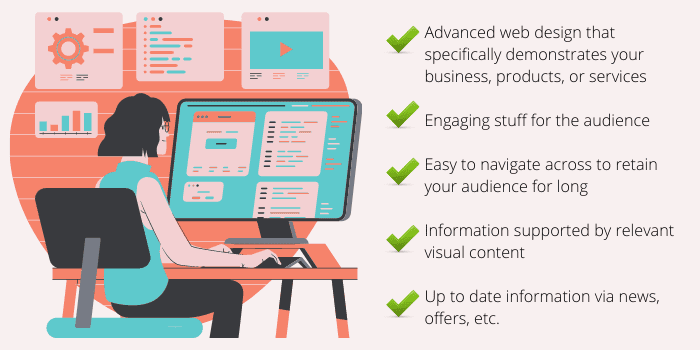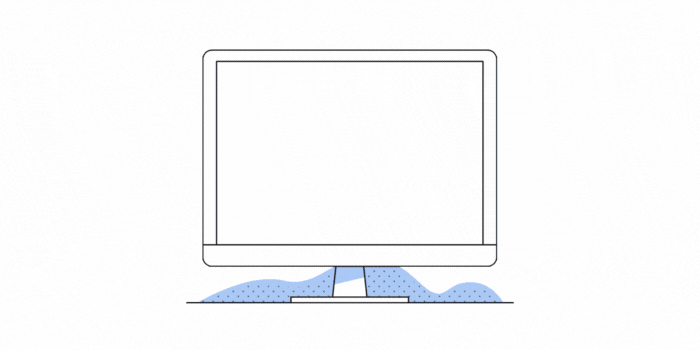Do you want to promote your business online?
It all starts with an awesome, intuitive, and user-friendly website.
To be very precise, you need a successful business website to reach your target audience with the brand message, engage them, and impact their purchase decision.
With years of experience in the industry, we understand what it takes to build a successful website to achieve maximum return on investment (ROI).
All site owners aspire to attract potential buyers, engage them, and boost sales on their website. Only a few of them actually manage to achieve these goals.
Vital elements to make a successful website

The problem (if any) only indicates either there is some key element(s) missing on your site or they are not working in proper coordination with others. It means you are simply losing conversion opportunities and leading potential customers to competitors.
If you already have a website, there is no need to build everything from scratch again. A few tweaks to get a professional look may be all you need to start improving. You don’t have to spend a fortune.
Here is a quick cheat sheet on what makes a successful website to help you engage the target audience, improve sales, and beat the competition.
1. Professional Web Design
Creating a website design is not about choosing a theme or working with the layout. Web development for a business site requires a lot of planning and a keen eye for detail.
Your audience is just a few clicks away from the competitor’s website. The website design is your first chance to give the visitors the right impression about your business, and it should be a great first impression. If you miss this opportunity and leave customers with a poor impression, or anything less than your competition, the rest of your digital marketing efforts will be far less effective.
In this age of tight competition, your website must have the following qualities:
- Aesthetic look and feel
- Clutter-free design so that your audience can easily skim through the contents
- Highly-functional
- Speed and performance focused
- Contain quality information
Website Aesthetics

94% of user experience first impressions are generated from the website design. (Source- WebFX)
When a visitor reaches a landing page, you have 0.05 seconds to create an impression. It all starts with the overall aesthetics of your website design.
You simply need a niche-oriented web design to represent your business.
Developing a website for a golf club and an accounting firm is not the same.
The golf club must have a lot of images, vibrant shades, and other visuals to appeal to let their target audience know what the experience at their club is truly like.
Conversely, you need to use a serious tone and subtle hues for the accounting firm’s website. The accountant should appear to be trustworthy, knowledgeable, stable, safe, and experienced.
Choose the colors wisely so that they are easy on the eyes and relevant to your brand.
Choose your fonts with care as well, and never use too many fonts on a single page. It creates confusion and spoils the appearance.
Try to use larger fonts that your audience can keep reading for a longer time. You don’t want to give them eye strain, do you? This is especially true on mobile devices.
Keep an Eye on the Load Speed
How long will you wait for a page to load entirely?
Not more than a couple of seconds, right?
A load speed greater than 1 second can bump up the bounce rate up to 123%. (Source- Think with Google)
Believe it or not, companies having websites with slow-load speed lose an estimated $2.6 billion every year. (Source- TDA)
It makes a lot of sense to take time to optimise your website speed and performance.
Optimise for Mobile Devices
74% of visitors are likely to return to websites with a good mobile interface. (Source- Martin Kairys)
Smartphones are getting bigger screen sizes with every new release, but that doesn’t mean you can be lazy with mobile usability. Your audience is online even when they are on the way to the office. If your site is difficult to browse on a mobile device, you are losing sales.
2. Follow Navigation Structure Best Practices
As you keep adding pages and content, the website grows bigger and can have a lot of internal links. If the links are not taking a visitor to the right page, it is only adding opportunities for them to exit your site without purchasing.
No one likes to click through a lot of links to find a piece of information. To avoid this, follow these navigation structure best practices to improve your user experience and decrease bounce rates:
- It should not take more than 3 clicks to find a piece of information
- Use contrasting solid colours, with bold, or underlined text to emphasise links.
- Organise the header navigation with fewer items to get a clutter-free look. Use sub-menus if you want to display more items.
- Highlight the items in the sidebar by using a different background colour.
- Maintain a sufficient gap between the sidebar text and the rest of the website content.
- Put navigation links where people generally expect to find them.
3. Call-to-Action (CTA) to Guide Your Audience

A strong CTA with a personalized message can boost conversion rates by over 202%. (Source- HubSpot)
When a visitor reaches your site, you want them to take an action, perhaps subscribe to your email list, download an e-book, purchase an item, etc.
Here are some easy tips to engage your audience with CTAs:
- Your call-to-action message should be clear to the audience
- Emphasise the CTA with a button linking to the desired page or action
- Use solid hues for the buttons that you want visitors to click
- Use short, action-oriented text for CTA buttons: Download, Sign Up, Buy Now, Add to Cart, Contact Us, etc.
- Place a CTA on the webpage layout before a visitor scrolls down the page so that they can see it as soon as the page loads.
4. Keep it Informative and Engaging
This can be tricky but is not impossible.
What happens when you enter a website and find no information at all?
You leave the site and look for the answer to your problem elsewhere. The same happens with your audience. They visit a website in search of some information, a solution to their problem, to purchase something, to hire someone, etc.
Your website creates no value unless you provide quality content to the audience.
The content on your website should engage your audience and help to build trust with them.
Here are a few considerations for your website content:
- Do you know the problems of your customers?
- Is the content easy to understand?
- Can it engage the readers?
- Are you providing accurate information?
- Is the content you are providing up to date?
- What type of content are you offering the audience?
While these are only some of the basic considerations you could start with, your content should be constantly evolving to meet the needs of your audience, and stay up to date.
Engage with Visual Content
The buzz over visual content has grown during the past decade and with good reason.
A great example of the benefits of visual content is simply giving directions. When people are provided with both text and illustrations, they do 323% better at following the directions than those with text only. (Source- HubSpot)
Similarly, articles containing images every 75-100 words get double the social media shares than those with fewer or no images. (Source- BuzzSumo)
There are various forms of visual content you can use to connect with your audience: photos, funny vectors, infographics, videos, GIFs, etc.
An explainer video of less than 2 minutes offers a better product demonstration than long text content that takes 5-6 minutes to read.
Visitors spend 88% more time on webpages containing videos. (Source- WebFX)
Should you remove all the text?
No way. There is a lot of information in the text and it is very important for both your SEO and for people who are not in an environment conducive to video content (eg slow internet, can’t listen to the audio, etc). Some information is also better conveyed in written format. For instance, it is easier to read (and compare) product features and specifications in plain text or a table format than in visual formats, especially if the product specifications involve a lot of technical data.
This is where you need to decide what type of content makes the most sense to use and where.
Homepage
A big chunk of your visitors will reach your homepage first before navigating to other parts of your website (unless you create a lot of targeted landing pages).
That means the home page is the most important page to give your visitors a clear understanding of your business, brand message, value proposition and so on. Your home page should demonstrate a brief idea of the product and services you provide, the value you can offer, and the problems you can solve.
Remember you are struggling to get ahead of hundreds or even thousands of competitors in the same niche as you.
The average time spent on a website is ‘less than 15 seconds’. (Source- Crazyegg)
The decision on whether a visitor will stay on a page or leave depends on first impressions. If they are not impressed, they leave. This means you get merely a fraction of a second to impress the visitors on the homepage.
Make sure everything is well organised, easy to navigate, looks good, loads fast, and works well on mobile too.
About Page
You can’t write everything on the homepage. If a visitor is impressed with the products and services you offer, but they have never heard of you before, the next step is often to check your ‘About Us’ page. New customers, especially service-based customers want to find information about your company and brand. They want to know if you can be trusted to solve their problem.
Keep it interesting and let your visitors know who you are. People aren’t looking for research papers or long boring histories on this page, but they do want to know about those things. So come up with a way to tell your story that is going to be interesting to your visitors and help show them why you can be trusted to solve their problems.
You may want to tell a story about your brand, how you founded it, what problems or needs brought you to where you are today, and who you were able to solve those needs. A concise and interesting ‘About Us’ page with relevant information does the trick.
Provide Multiple Choices to Contact You
64% of customers want to see the contact information before proceeding further or responding to a CTA. Listing your contact details publicly helps to build trust and facilitates communication in the way that your potential customer prefers. Sometimes this is just because they want to know where you are located, other times it’s to see what type of phone number and email address you are using. These things contribute to customer trust.
If a customer likes your website, they may also like to get in touch for more information, a pre-sales query, and much more. If your contact information is not readily accessible, it can put the site’s trustworthiness and credibility at stake and reduce your enquiry rates. A great option to help boost enquiry rates is a tool like EnquiryBot, but this doesn’t replace the need to have your contact details available.
Choose several locations on your website in addition to the contact page to show your contact information. Some common locations are the top navigation bar, footer, or homepage sidebar. Just remember to make it easy to find. You want it to be easy for potential customers to contact you.
5. Brand Mentions – Are You Doing It Right?

When we talk of brand mentions, there are so many ways that this can happen. It could be current news, trending offers, social proof, backlinks, unlinked promotions, social shares and many more.
Brand mentions should be part of your overall strategy to promote your website, products and services.
Up-to-date news releases
Before you go hunting for backlink opportunities, or plan out a link-building strategy (more on this soon), check the last time you have published a news update or an offer on your website.
Do you often publish blogs, press releases or promotions?
Suppose that you visit a website where the most recent news release was from 2013. You start wondering if they are doing anything right now even though the site is live. Is the site actually up to date? Is it trustworthy?
People are more likely to trust a website that releases at least one blog post, press article or offer per month. Even if it is just updating a previous article with new dates. New content is better, but as long as the content has been updated and shows a recent date, that is better than old content.
Social proof
70% of consumers read your customer reviews before purchasing a product or choosing a service. (Source- Optinmonster)
Today everyone is looking for social proof before choosing products and services. Your customers are on Instagram, Facebook, Twitter, etc. Apart from social networking sites, people also ask questions on Google and Quora to find more information and answers to their questions about you.
Building social proof is an integral part of any digital marketing campaign in the social age. Encourage your customers to leave feedback and reviews, both on your site (if practical), and on social review platforms like Google, Facebook, TripAdvisor and so on. Leverage this social proof on your website and via your marketing channels.
What about backlinks and unlinked promotions?
Everyone is aware of the mighty power of backlinks. However, most webmasters struggle to get high-quality links from authoritative niche sources to their websites. As I mentioned earlier, having up to date content that is relevant to your customers is a must. This can help to generate backlinks simply by virtue of existing, but it also gives you pages on various related topics that you can use in your link-building strategies.
It’s good if you are already working on building backlinks to your website, but if not, there is no better time to start. Backlink opportunities often come in the form of a link associated with more information, a citation (or quote), or guest blog posts.
Then there are unlinked brand mentions. This is something that has existed for a long time, but in the age of AI-powered search, it is becoming increasingly important.
As the name suggests, unlinked brand mention do not contain a link to your website.
Brand mentions without a link! How will visitors reach my website I hear you asking?
This is a major concern. However, when your brand name is mentioned on popular websites in relevant industries, it raises awareness about your products and services and trust in your business. These mentions can also help to contribute to contextual awareness in search. Of course, it’s always better to get a link too. Opportunities without links should still be considered though as part of your brand marketing strategy.
Start Building a Successful Website for Your Business
A professional business website forms the foundation for a successful business website marketing campaign. It conveys your brand message and raises awareness to grab the attention of potential buyers. A successful business website takes this attention and converts visitors into enquiries and sales.
I hope this article has provided some insight on how to make a website successful using our 5 key elements.
Need a successful website for your business? We can help. Please feel free to get in touch. Our web designers and digital marketing professionals can help you to make it all happen.


